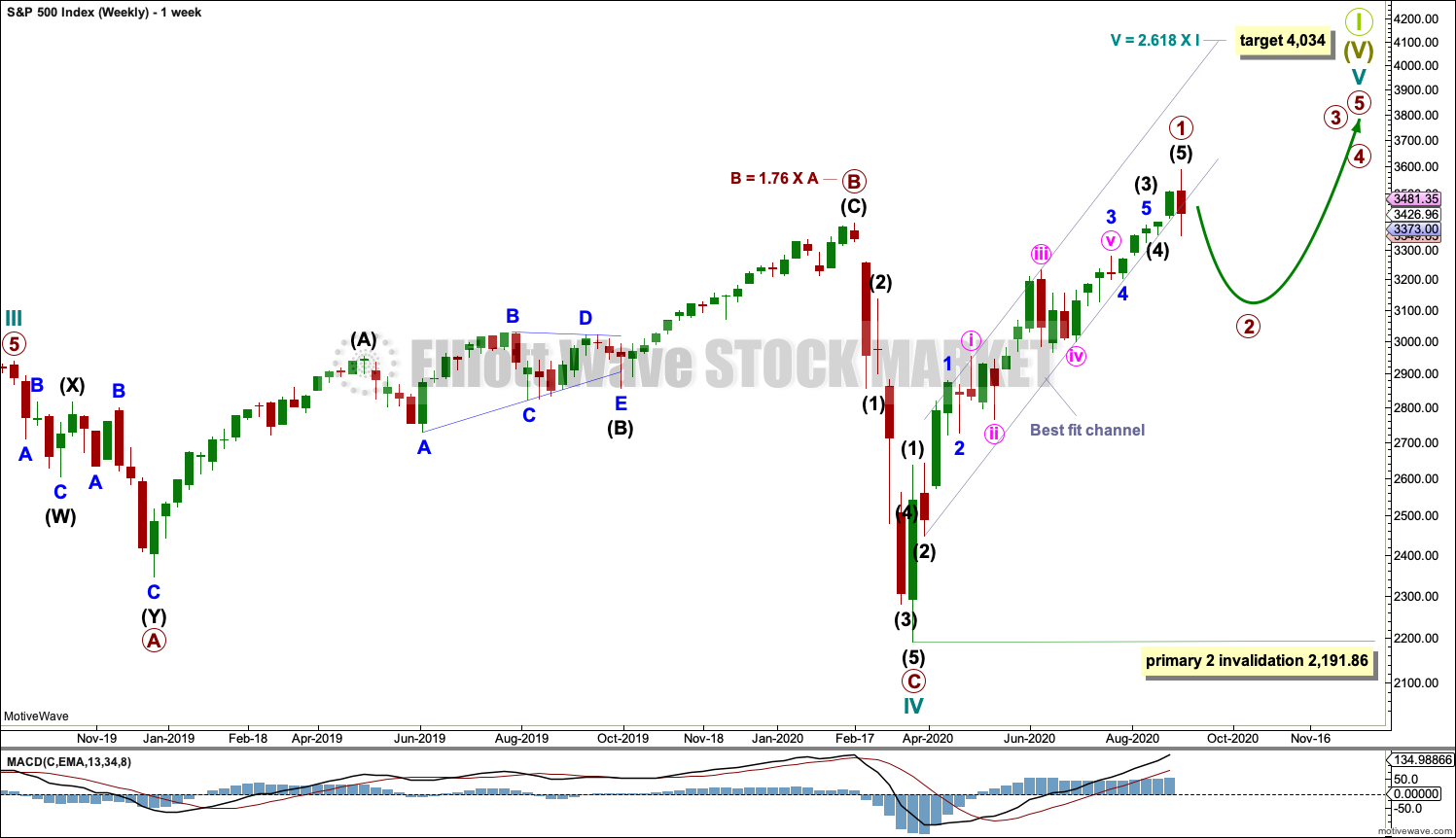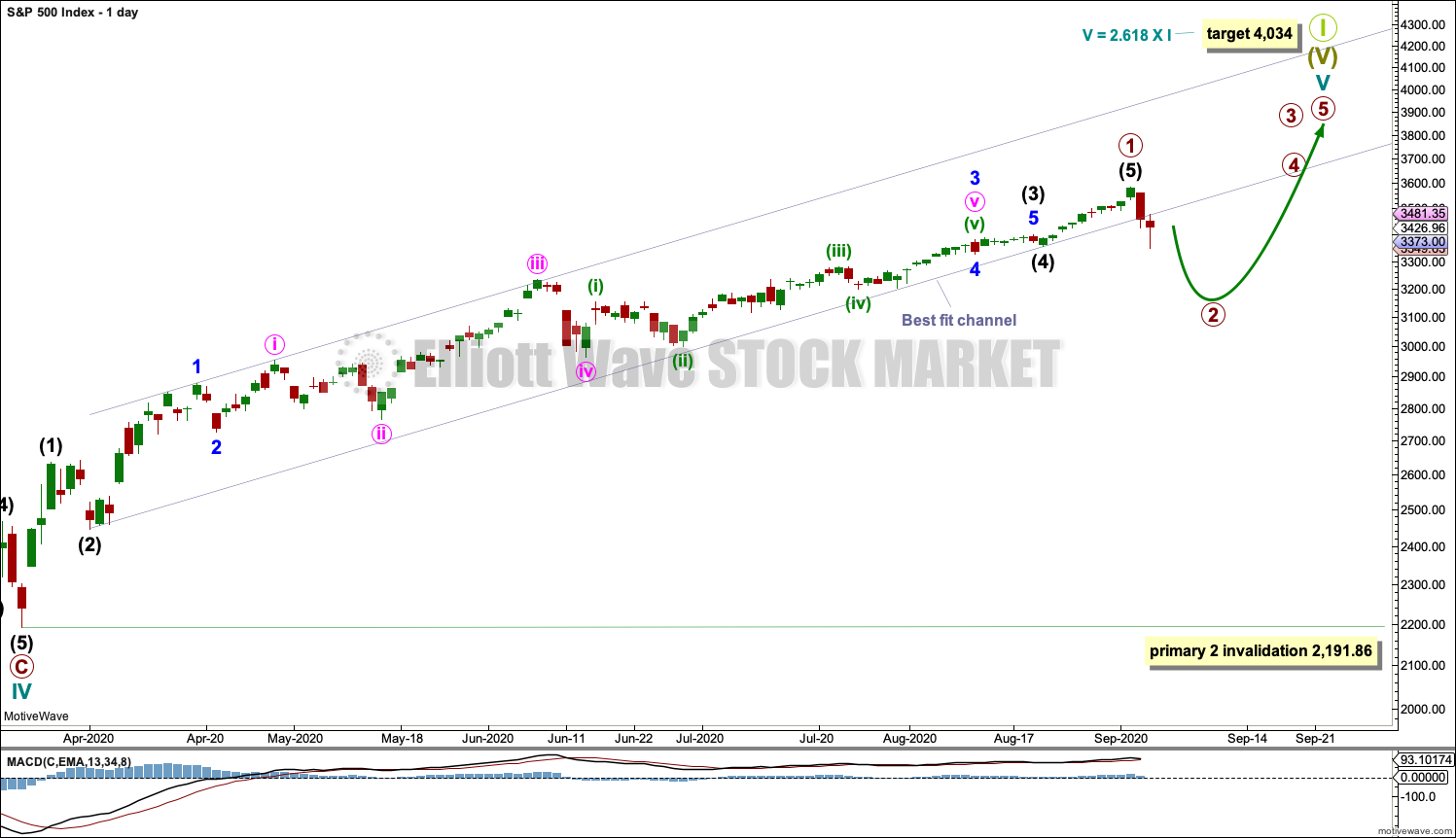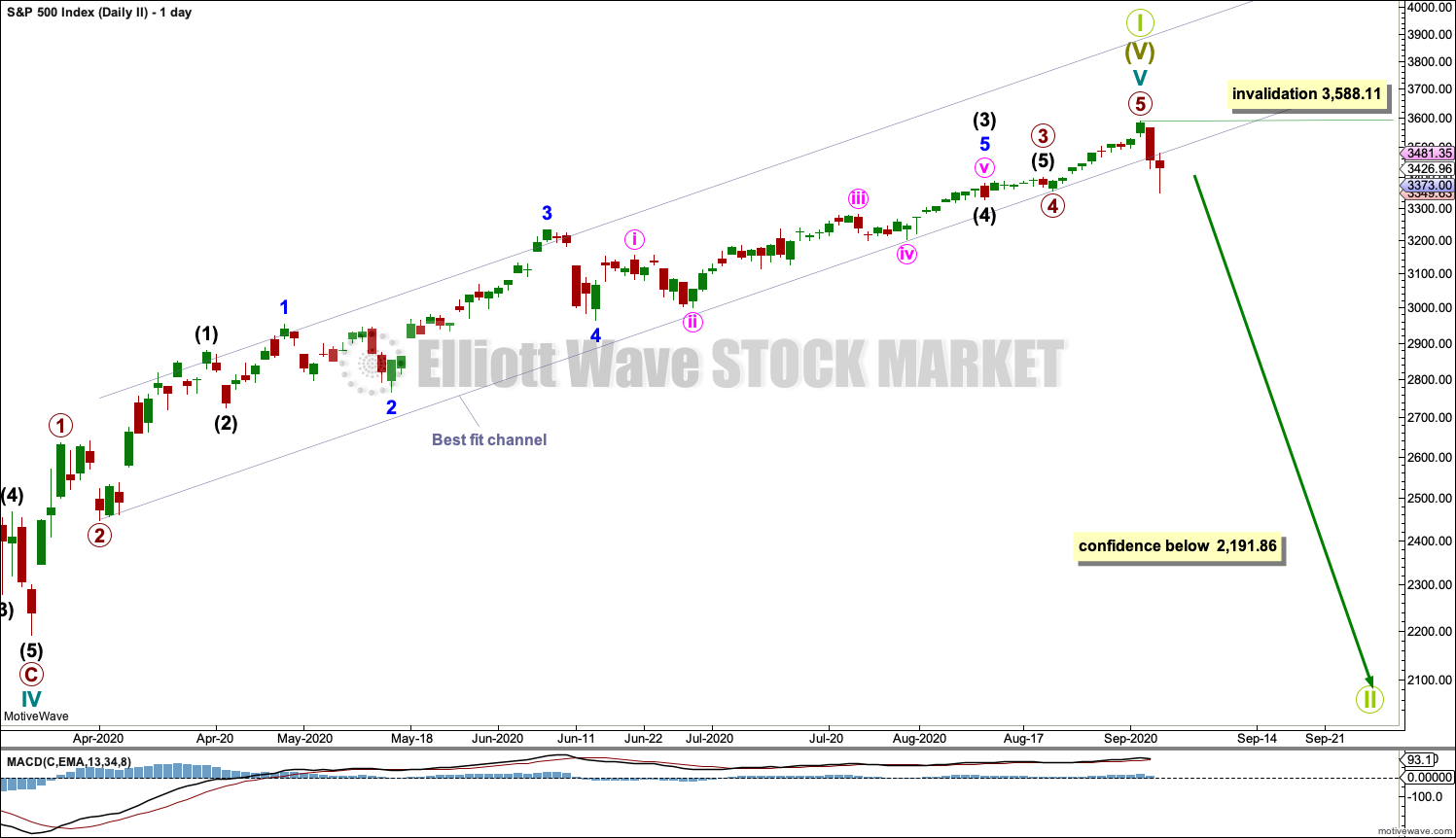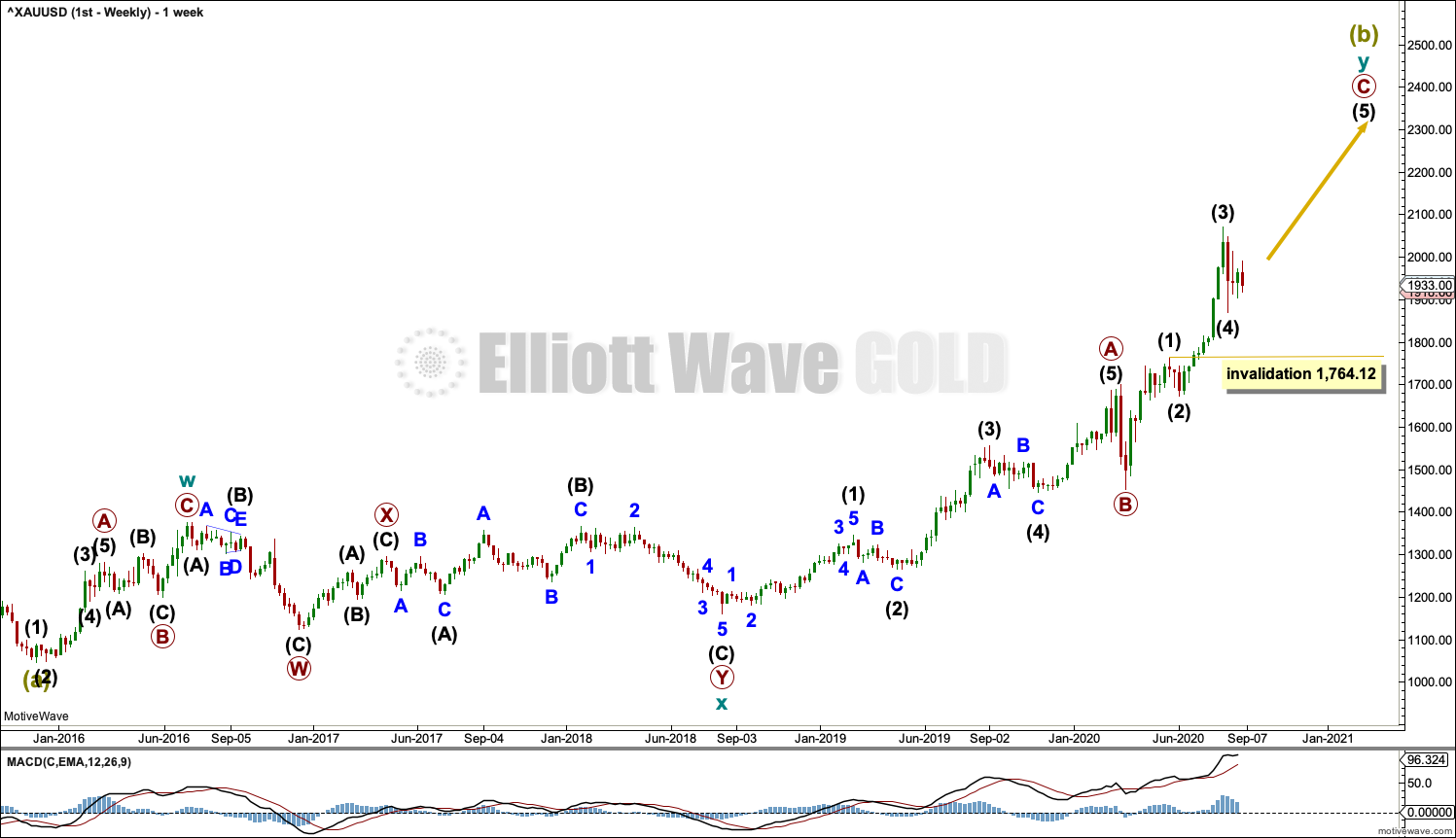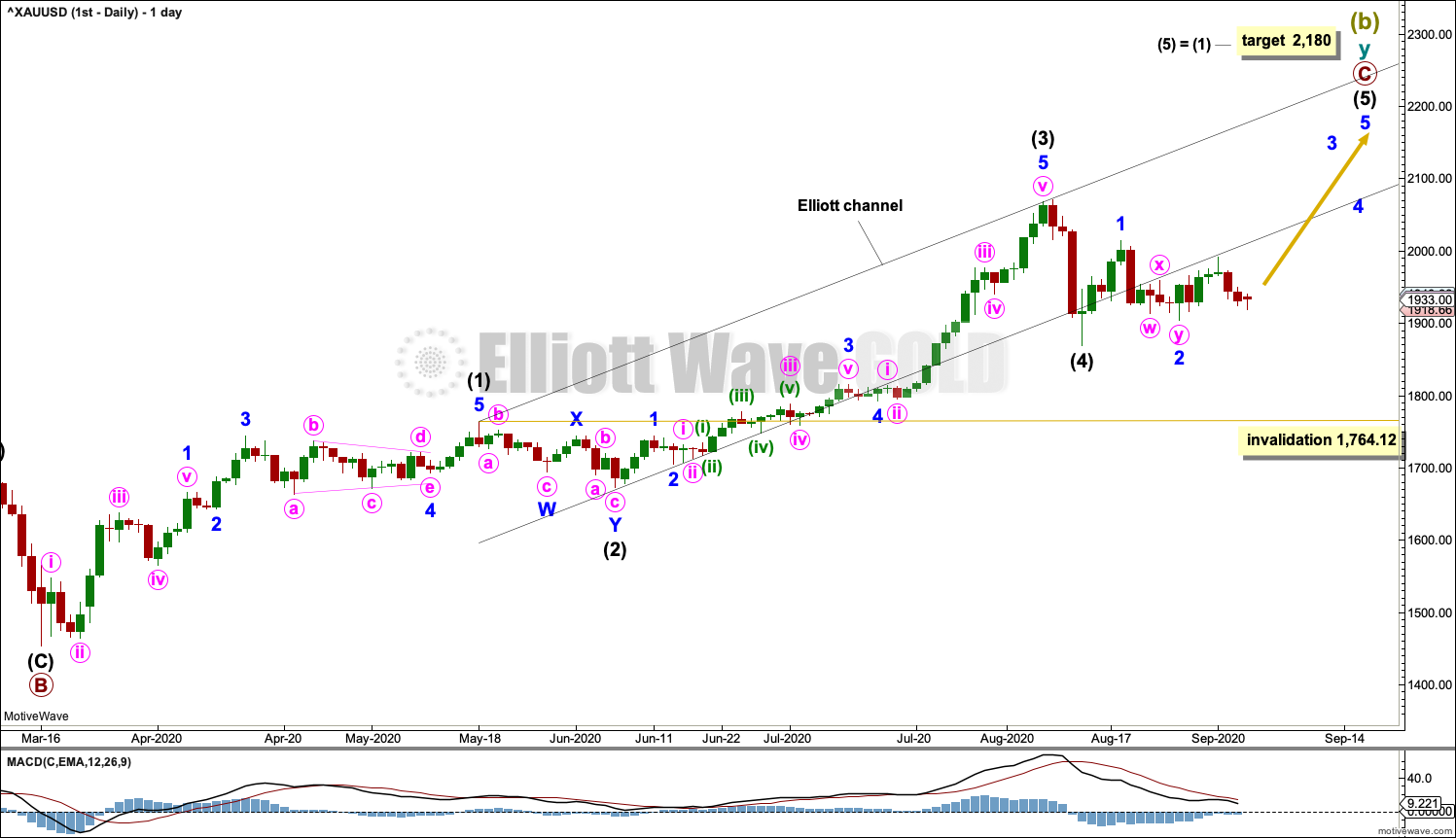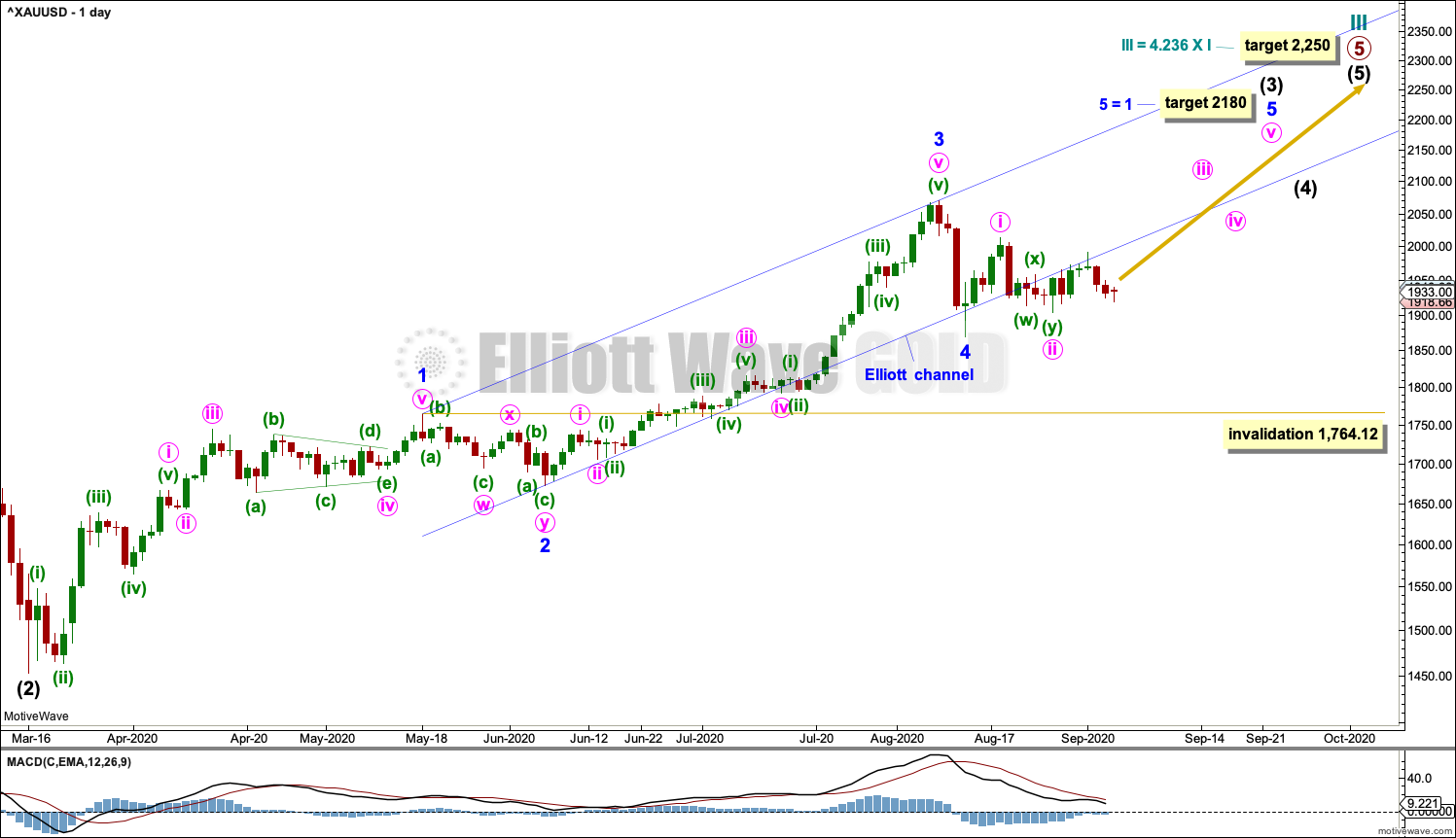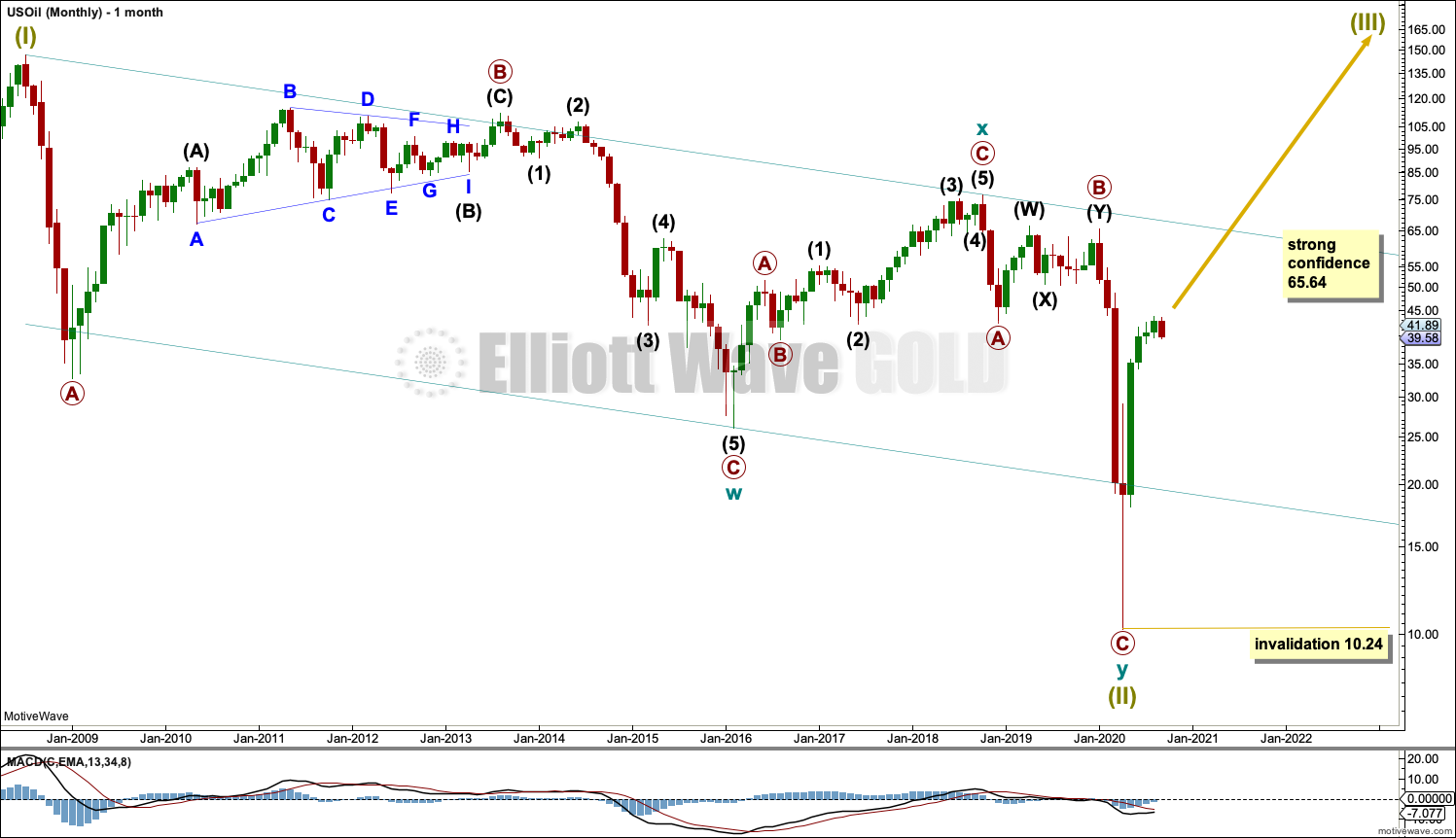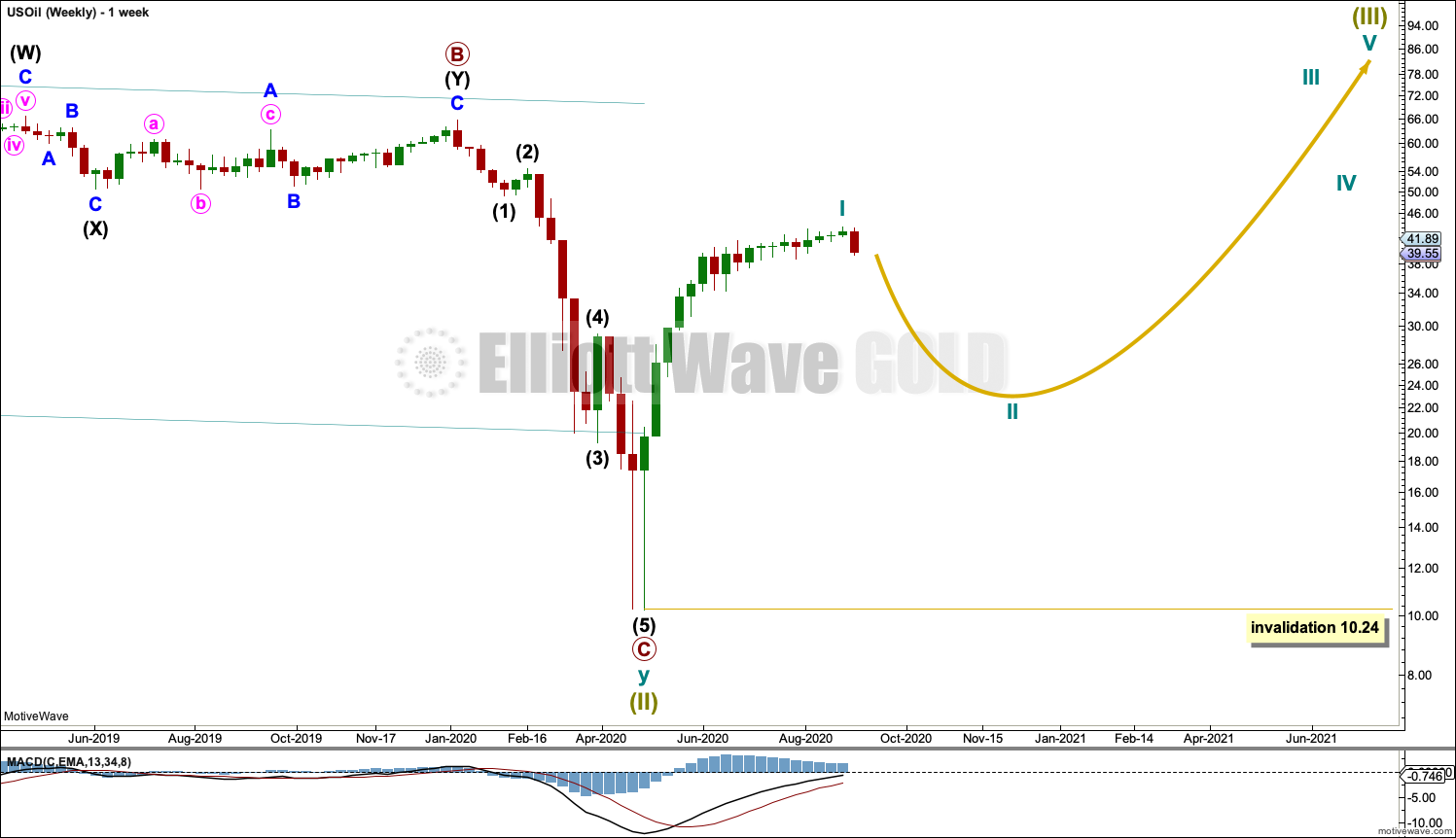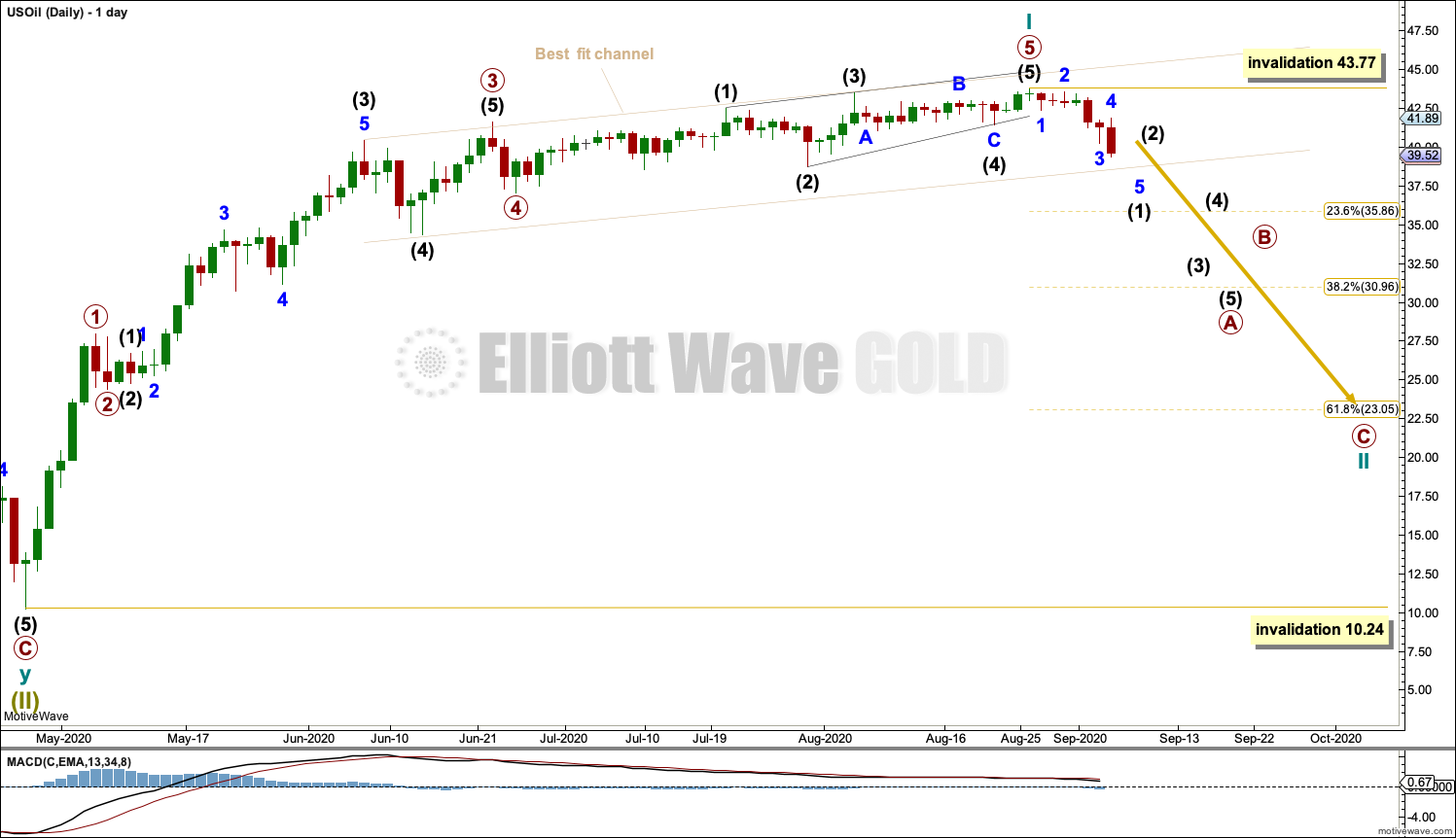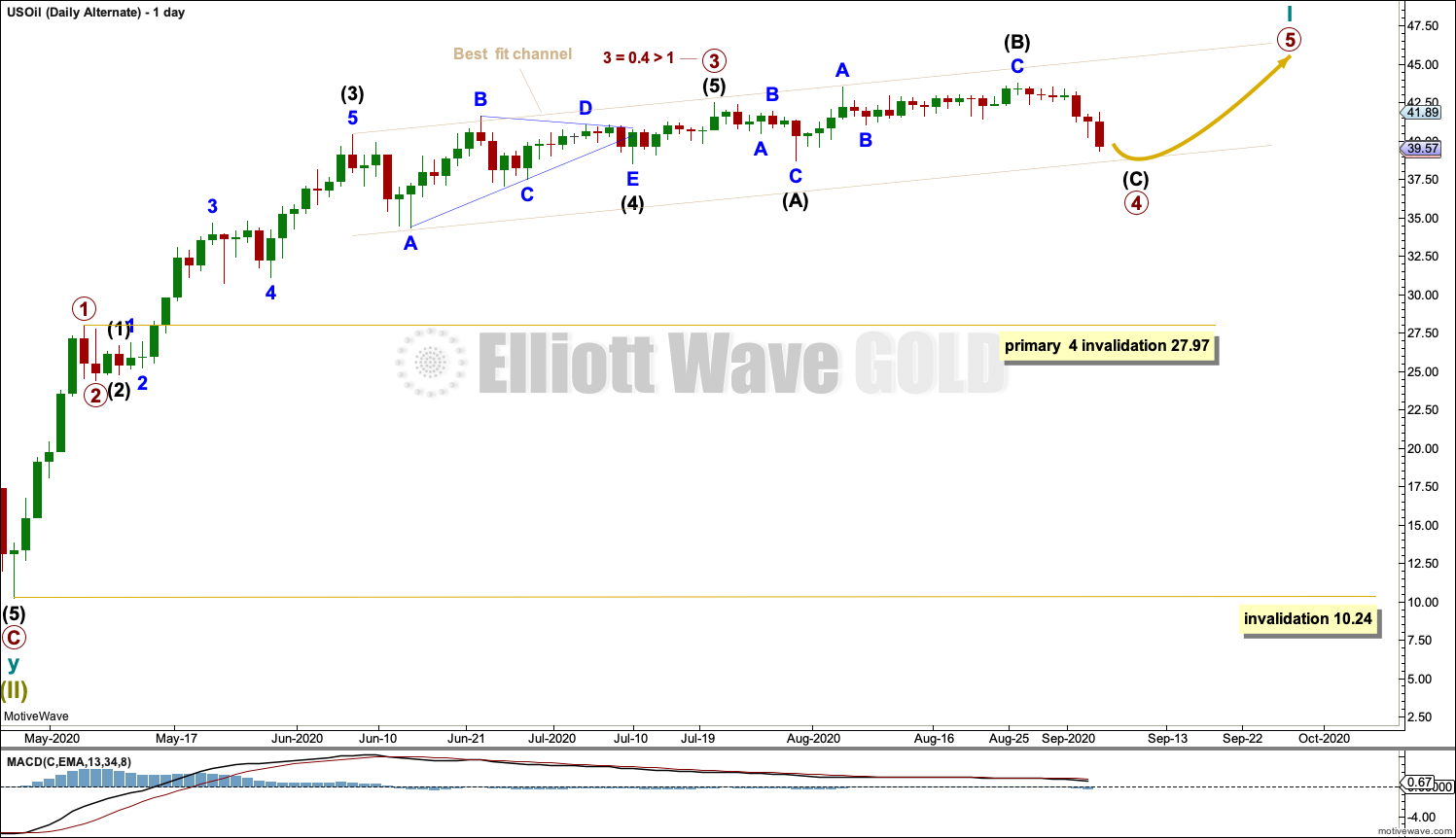Lara’s Weekly: Elliott Wave and Technical Analysis of S&P500 and Gold and US Oil | Charts – September 4, 2020

S&P 500
A new low below 3,354.68 in the second hour of the session invalidated two of four short-term Elliott wave counts.
This correction may be either of primary degree or possibly a new Grand Super Cycle trend.
Summary: For the short term, a bounce may happen on Monday. It may find resistance about 3,497. Thereafter, downwards or sideways movement may continue.
The first wave count expects that a pullback or consolidation to last about one to a few weeks has begun. It may find support about 3,055 or 2,725.
The second wave count considers the possibility that a once in multi-generations trend change may have just occurred. Some confidence in this wave count would come with invalidation of the first wave count below 2,191.86.
The biggest picture, Grand Super Cycle analysis, is here.
Last monthly charts are here. Video is here.
ELLIOTT WAVE COUNTS
FIRST WAVE COUNT
WEEKLY CHART
Cycle wave V may last from one to several years. So far it has lasted 6 months.
Cycle wave V would most likely subdivide as an impulse. But if overlapping develops, then an ending diagonal should be considered. This chart considers the more common impulse.
Primary wave 1 may be complete. Primary wave 2 may not move beyond the start of primary wave 1 below 2,191.86.
There is already a Fibonacci ratio between cycle waves I and III within Super Cycle wave (V). The S&P500 often exhibits a Fibonacci ratio between two of its actionary waves but rarely between all three; it is less likely that cycle wave V would exhibit a Fibonacci ratio. The target for Super Cycle wave (V) to end would best be calculated at primary degree, but that cannot be done until all of primary waves 1, 2, 3 and 4 are complete. The target at 4,034 is provisional, so it may change.
DAILY CHART
A target is calculated for intermediate wave (5) to complete primary wave 1, based upon the most common Fibonacci ratio to intermediate wave (1).
The best fit channel is adjusted. It is breached by Friday’s candlestick.
Primary wave 1 may be over and primary wave 2 may have begun. For the short term, a new low below 3,354.69 indicates an end to primary wave 1.
Primary wave 2 may be a multi-week pullback or consolidation. Primary wave 2 may not move beyond the start of primary wave 1 below 2,191.86.
SECOND WAVE COUNT
DAILY CHART
This wave count is the same as the first wave count with the exception of the degree of labelling within cycle wave V. If the degree of labelling is moved up one degree, then it is possible that cycle wave V to end Super cycle wave (V) to end Grand Super Cycle wave I is complete.
A new low below 2,191.86 would add confidence in this wave count. At that stage, the first wave count would be invalidated.
A new bear market at Grand Super Cycle degree may be expected to last over a decade. It may take price below the start of Super Cycle wave (V) at 666.79 in March 2009.
TECHNICAL ANALYSIS
WEEKLY CHART
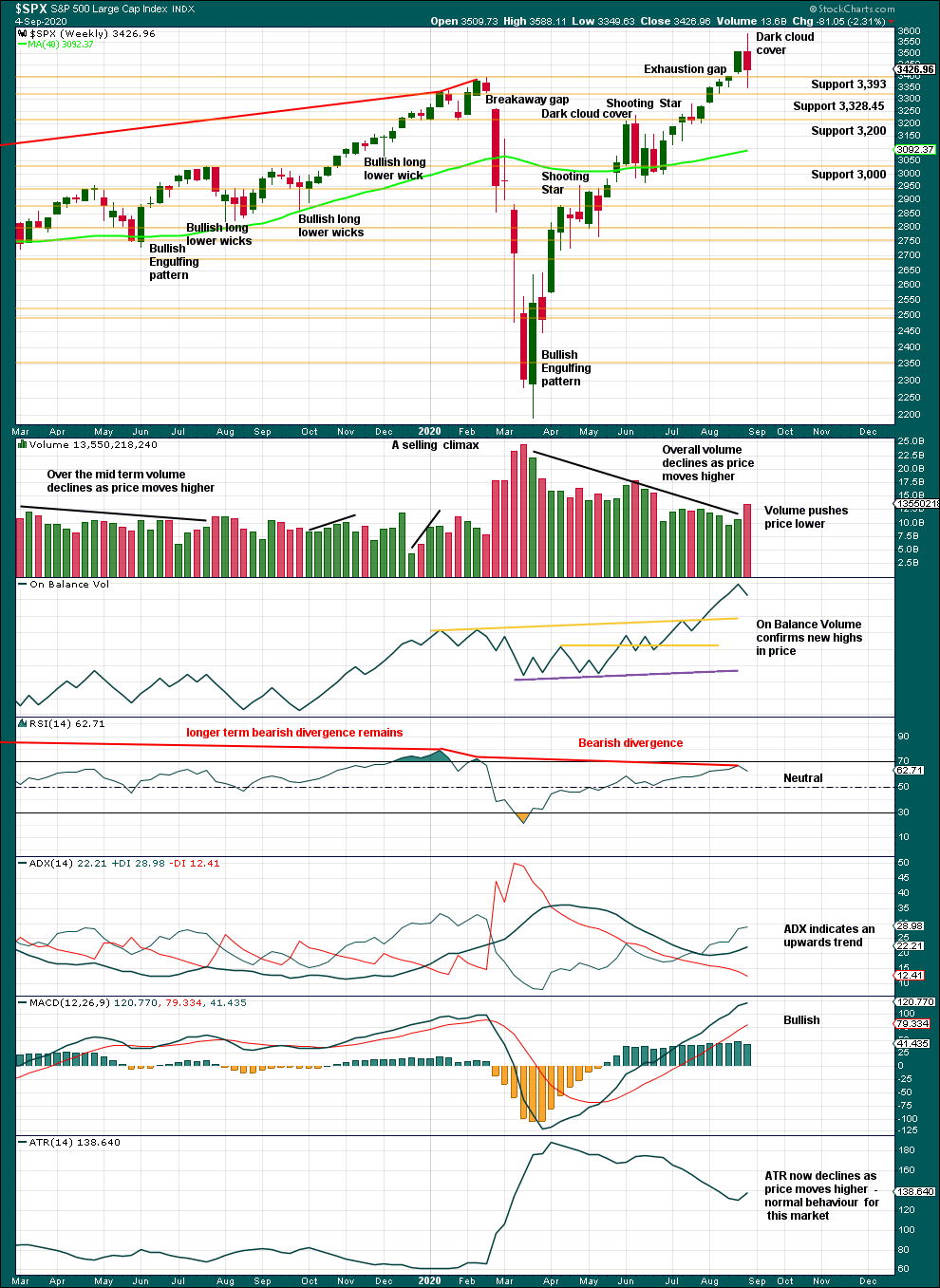
Click chart to enlarge. Chart courtesy of StockCharts.com.
ADX indicates an upwards trend. However, with RSI exhibiting bearish divergence and this week’s bearish candlestick reversal pattern having support from volume, further pullback or consolidation at least for the short term may be expected here.
DAILY CHART
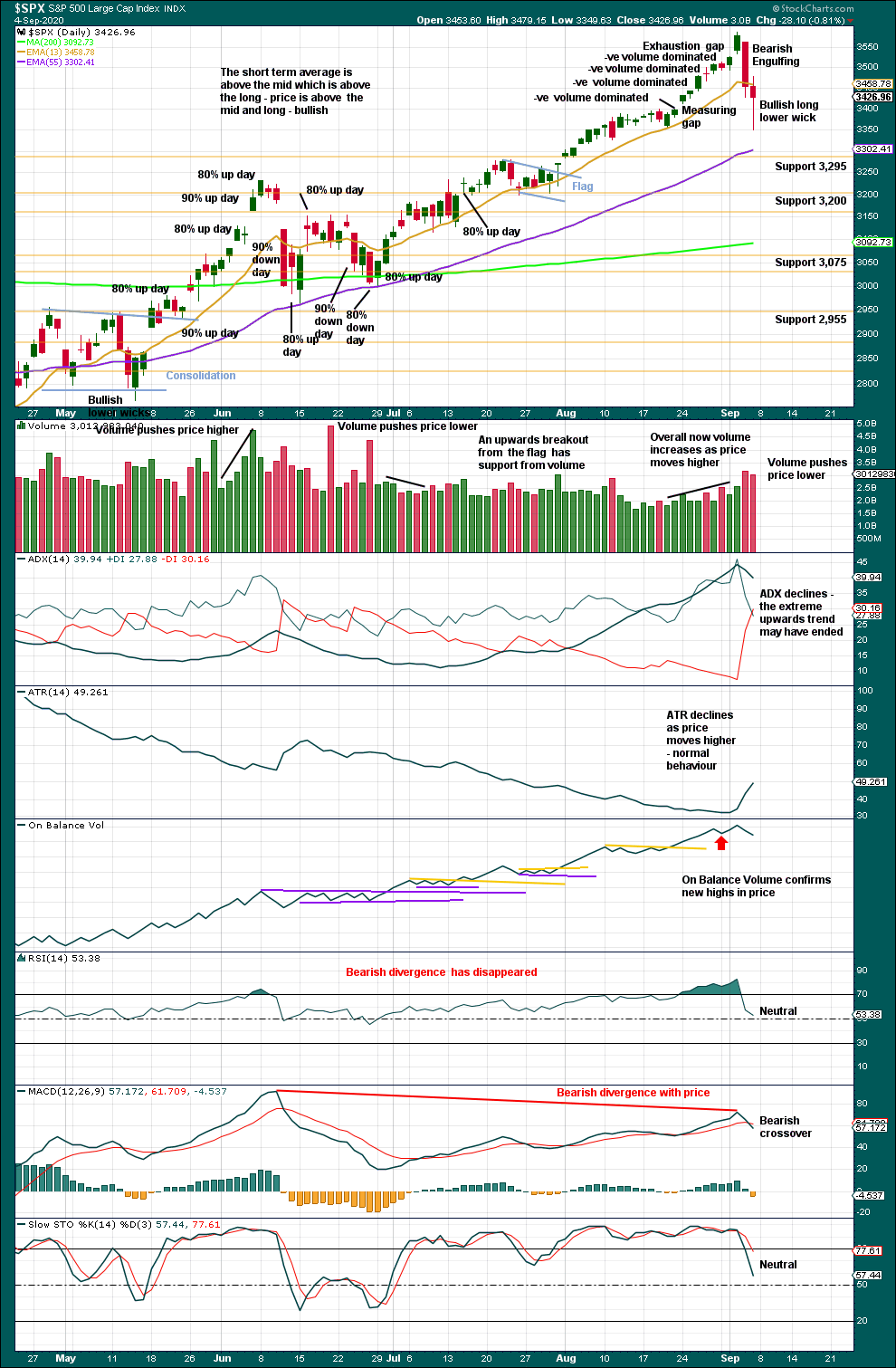
Click chart to enlarge. Chart courtesy of StockCharts.com.
Down volume dominated for four sessions within the last nine sessions in a row of upwards movement.
RSI and ADX both reached extreme.
In extreme conditions a bearish candlestick pattern should be given weight; a trend change should be expected to be either downwards or sideways. Bearish candlestick patterns make no comment on the direction of the next trend (either a consolidation to relieve extreme conditions or a full 180° reversal) nor on how long the new trend may last.
The bearish candlestick pattern has support from volume. However, three prior Bearish Engulfing patterns can be seen on this chart on 12th of May, 11th June and 11th of August. None were followed by any substantial downwards movement; all were short-term corrections within an ongoing upwards trend.
A new low below 3,354.69 gives some confidence in a trend change.
For the very short term, a bullish long lower wick on Friday’s candlestick suggests upwards movement on Monday.
BREADTH – AD LINE
WEEKLY CHART
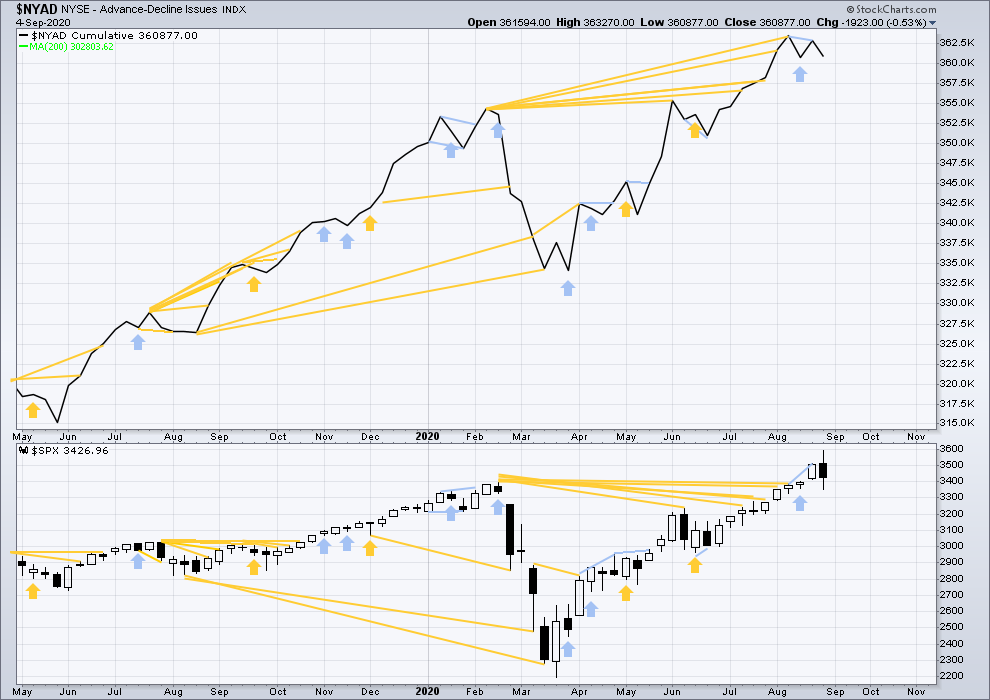
Click chart to enlarge. Chart courtesy of StockCharts.com. So that colour blind members are included, bearish signals will be noted with blue and bullish signals with yellow.
Breadth should be read as a leading indicator.
Lowry’s Operating Companies Only AD line has still not made new all time highs. The last high for the OCO AD line was in the week beginning January 13, 2020. There is now 7 and a half months of bearish divergence between price and the OCO AD line. This may now support the more bearish second wave count. It is possible now that a major trend change may occur.
The NYSE All Issues AD line made new highs in the week beginning 1st of June.
This week both price and the AD line have moved lower. There is no new divergence.
Large caps all time high: 3,588.11 on September 2, 2020.
Mid caps all time high: 2,109.43 on February 20, 2020.
Small caps all time high: 1,100.58 on August 27, 2018.
This rise has been led by large caps, which is a feature of an aged bull market. Only large caps have made new highs above the last swing high of the 11th of August.
DAILY CHART

Click chart to enlarge. Chart courtesy of StockCharts.com. So that colour blind members are included, bearish signals will be noted with blue and bullish signals with yellow.
Both price and the AD line have moved lower on Friday. Price has made a slight new low below the prior low of the 20th / 21st of August, but the AD line has not. This divergence is bullish and supports the first Elliott wave count, but it is very slight and so the support is slim.
VOLATILITY – INVERTED VIX CHART
WEEKLY CHART
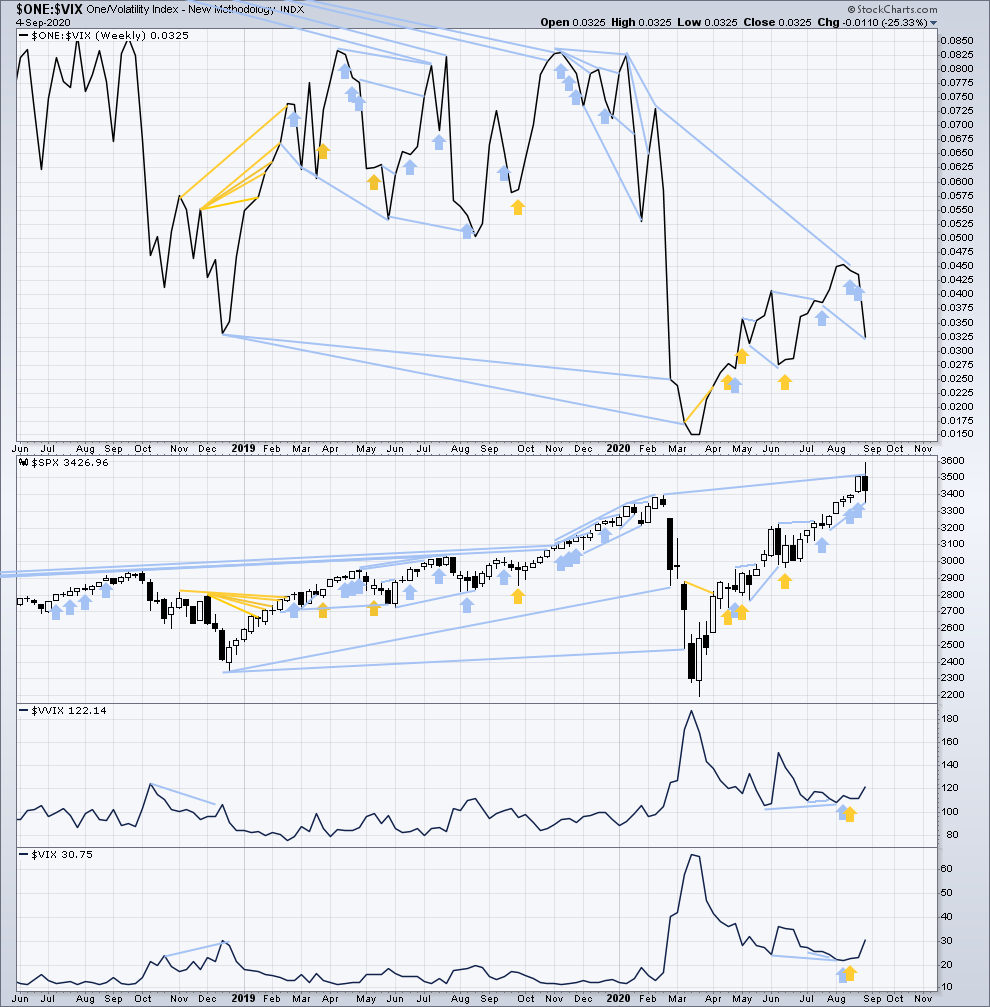
Click chart to enlarge. Chart courtesy of StockCharts.com. So that colour blind members are included, bearish signals will be noted with blue and bullish signals with yellow.
Inverted VIX remains well below all time highs. The all time high for inverted VIX was in the week beginning October 30, 2017. There is nearly 3 years of bearish divergence between price and inverted VIX. There is all of long, mid and short-term bearish divergence.
Both price and inverted VIX have moved lower this week. Inverted VIX has made a strong new low below the low of the week beginning 21st of July, but price has not. This divergence is bearish.
Comparing VIX and VVIX: From weeks beginning 1st June to three weeks ago, VIX has made new lows as price has made new highs, but VVIX has failed to make corresponding new lows with VIX. VVIX remains slightly elevated. This divergence is not strong, but it is bearish for price.
DAILY CHART
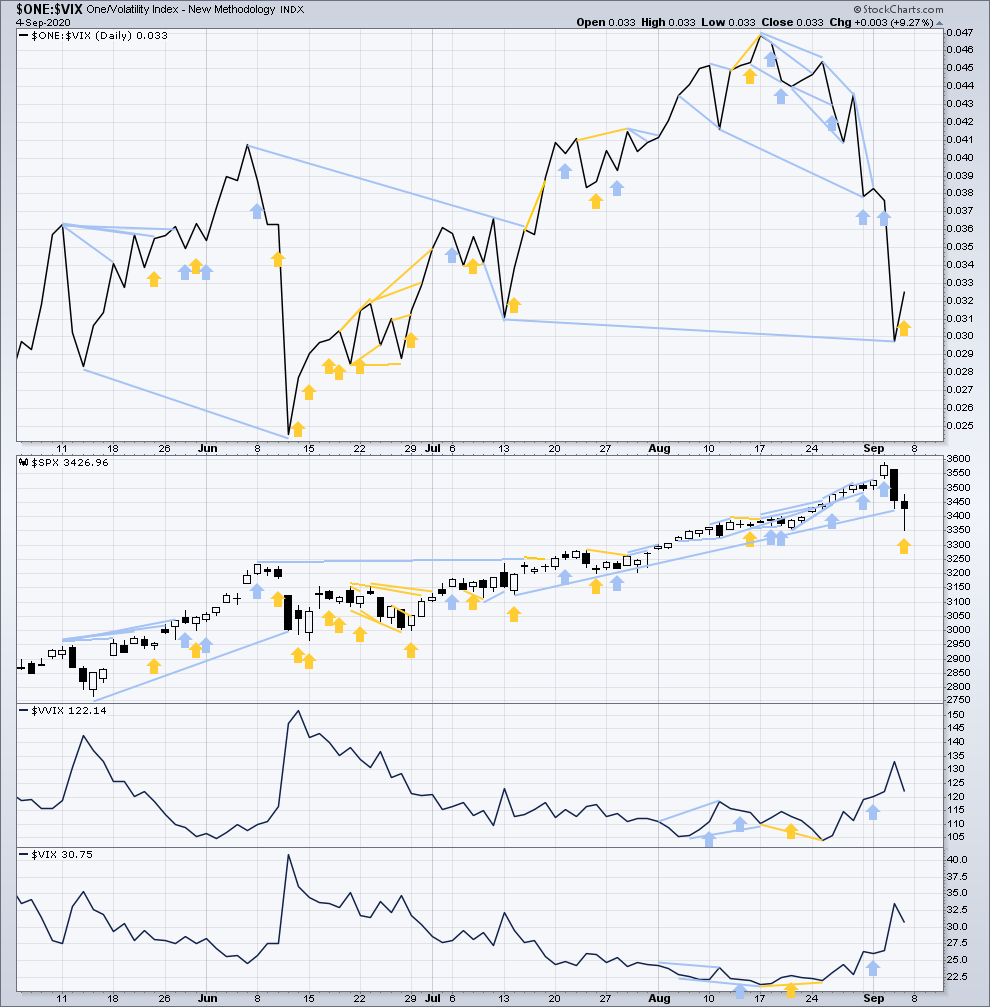
Click chart to enlarge. Chart courtesy of StockCharts.com. So that colour blind members are included, bearish signals will be noted with blue and bullish signals with yellow.
On Friday price has moved lower, but inverted VIX has moved higher. This divergence is bullish for the short term.
Comparing VIX and VVIX at the daily chart level: Both have moved higher today. There is no new divergence.
DOW THEORY
Dow Theory still concludes a bear market is in place.
Dow Theory confirmed a bear market with the following lows made on a closing basis:
DJIA: 21,712.53 – a close below this point was been made on the March 12, 2020.
DJT: 8,636.79 – a close below this point was been made on March 9, 2020.
Adding in the S&P and Nasdaq for an extended Dow Theory, a bear market was confirmed:
S&P500: 2,346.58 – a close below this point was made on March 20, 2020.
Nasdaq: 7,292.22 – a close below this point was made on the March 12, 2020.
At this time, to shift Dow Theory from viewing a bear market to confirmation of a new bull market would require new highs made on a closing basis:
DJIA: 29,568.57
DJT: 11,623.58
Adding in the S&P and Nasdaq for an extended Dow Theory, confirmation of a bull market would require new highs made on a closing basis:
S&P500: 3,393.52 – closed above on 21st August 2020.
Nasdaq: 9,838.37 – closed above on June 8, 2020.
GOLD
A triangle pattern may be complete at today’s low.
Summary: The pullback may be over. The upwards trend may resume.
The next target is now at 2,180.
A new low below 1,764.12 at any time frame would invalidate the first daily chart and add confidence in an alternate daily chart. At that stage, a sustainable high would be in place and either a cycle degree fourth wave or a Super Cycle degree C wave down may be underway.
Grand SuperCycle analysis is here.
Last analysis of monthly charts is here with video here.
FIRST ELLIOTT WAVE COUNT
WEEKLY CHART
The bigger picture for this first Elliott wave count sees Gold as still within a bear market, in a three steps back pattern that is labelled Grand Super Cycle wave IV on monthly charts. The common range for Super Cycle wave (b) is from 1 to 1.38 times the length of Super cycle wave (a), giving a range from 1,920.18 to 2,252.27. The target would see Super Cycle wave (b) end within this most common range.
Super Cycle wave (b) within Grand Super Cycle wave IV may be an incomplete double zigzag. When Super Cycle wave (b) may be complete, then this wave count expects Super Cycle wave (c) to begin and to move price below the end of Super Cycle wave (a) at 1,046.27.
The first zigzag in the double is labelled cycle wave w. The double is joined by a three in the opposite direction, a combination labelled cycle wave x. The second zigzag in the double is labelled cycle wave y.
The purpose of the second zigzag in a double is to deepen the correction. Cycle wave y has achieved this purpose.
Primary wave C within cycle wave y may be subdividing as an impulse. Intermediate waves (1) through to (4) within primary wave C may be complete. If it continues any lower, then intermediate wave (4) may not move into intermediate wave (1) price territory below 1,764.12.
We should always assume the trend remains the same until proven otherwise. At this stage, Gold is in a bull market.
DAILY CHART
The daily chart shows detail of primary wave C as an incomplete impulse.
Intermediate waves (1) through to (4) within primary wave C may be complete. It is also possible that intermediate wave (4) may end at today’s low as a triangle.
If it continues lower, then intermediate wave (4) may not move into intermediate wave (1) price territory below 1,764.12.
Draw an Elliott channel: draw a first trend line from the end of intermediate wave (1) to the end of intermediate wave (3), then place a parallel copy on the end of intermediate wave (2). Intermediate wave (4) may have overshot the lower edge.
Intermediate wave (2) was a shallow double zigzag, lasting 15 sessions. Intermediate wave (4) may be complete as a deeper and quicker single zigzag. Fourth waves are most often more brief than their counterpart second wave corrections for this market, so it would look normal for intermediate wave (4) to be over here.
ALTERNATE DAILY CHART
It is also possible that a Super Cycle degree trend change has occurred at the last high. However, we should always assume the trend remains the same until proven otherwise. Assume the upwards trend remains in place and the main wave count is correct until the upwards trend is invalidated with a new low below 1,764.12. At that stage, this would become the main wave count.
Super Cycle wave (c) would be likely to make at least a slight new low below the end of Super Cycle wave (a) at 1,046.27 to avoid a truncation. If price provides confidence in this wave count with a new low below 1,764.12, then a target would be calculated for Super Cycle wave (c) to end.
SECOND ELLIOTT WAVE COUNT
WEEKLY CHART
This wave count sees the the bear market complete at the last major low for Gold on 3 December 2015.
If Gold is in a new bull market, then it should begin with a five wave structure upwards on the weekly chart.
Cycle wave I fits as a five wave impulse with reasonably proportionate corrections for primary waves 2 and 4.
Cycle wave II fits as a double flat. However, within the first flat correction labelled primary wave W, this wave count needs to ignore what looks like an obvious triangle from July to September 2016 (this can be seen labelled as a triangle on the bear wave count above). This movement must be labelled as a series of overlapping first and second waves. Ignoring this triangle reduces the probability of this wave count in Elliott wave terms.
Cycle wave III may be incomplete. Cycle wave IV may not move into cycle wave I price territory below 1,303.51.
DAILY CHART
Cycle wave III may be continuing higher. The daily chart focusses on primary wave 5 within cycle wave III.
Draw an Elliott channel about intermediate wave (3): draw the first trend line from the end of minor wave 1 to the end of minor wave 3, then place a parallel copy on the end of minor wave 2. Minor wave 4 may have overshot the lower edge of the channel.
If minor wave 4 continues lower, then it may not move into minor wave 1 price territory below 1,764.12.
TECHNICAL ANALYSIS
WEEKLY CHART
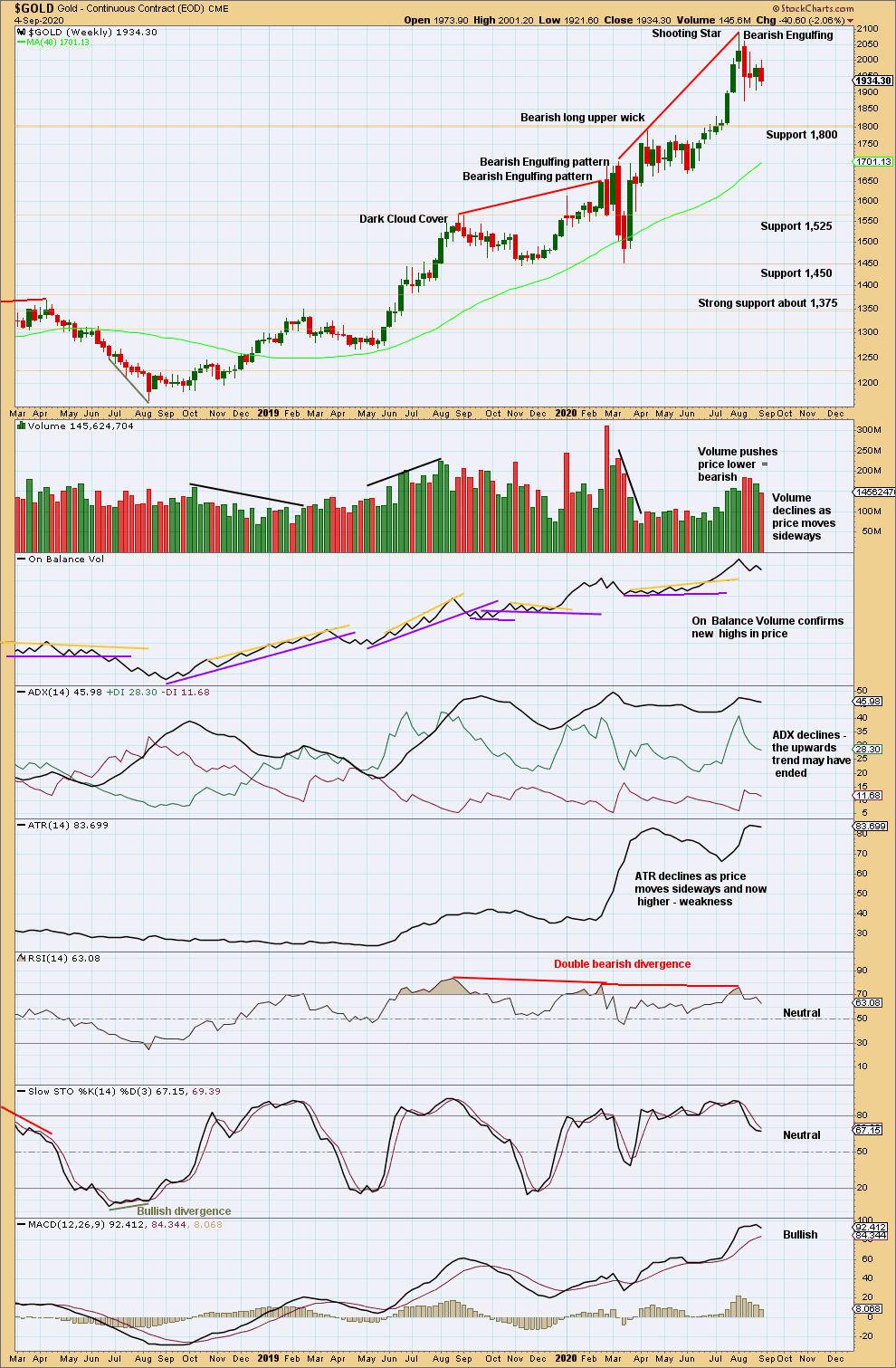
Click chart to enlarge. Chart courtesy of StockCharts.com.
The upwards trend reached very extreme and RSI reached overbought. A Shooting Star and a Bearish Engulfing candlestick pattern appear at the high. Given extreme conditions, these bearish reversal patterns should be given weight; this would support the alternate daily chart. However, it is still possible that further highs may be made before a more time consuming pullback or a 180° trend change may occur.
So far sideways movement of the last 3 weeks has brought RSI down from extreme, but not by much. ADX remains high. If the upwards trend continues here, it may be limited.
DAILY CHART
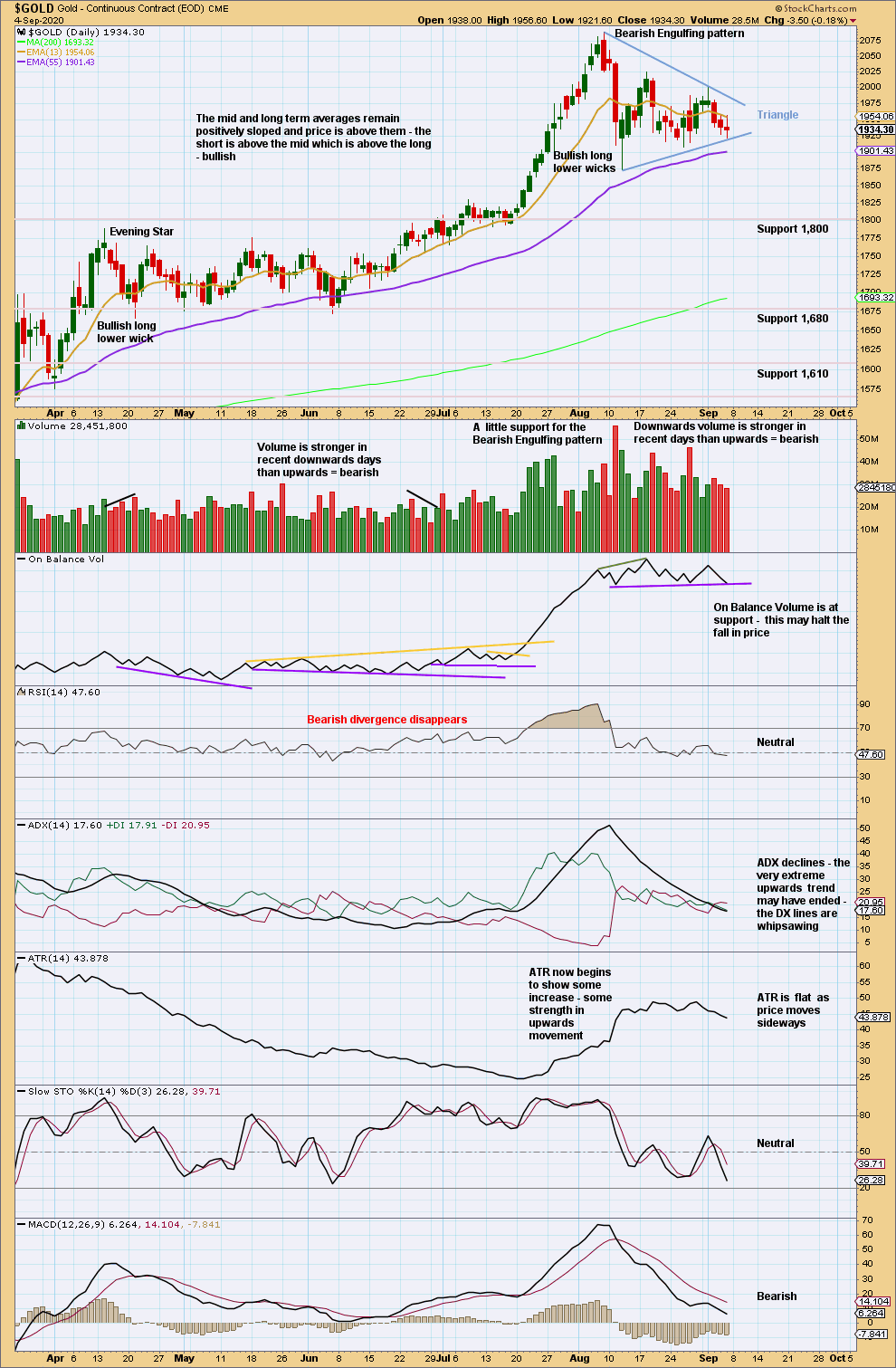
Click chart to enlarge. Chart courtesy of StockCharts.com.
Sideways movement of the last two weeks has brought ADX and RSI down from extreme. There is again room for a trend to develop.
A triangle may be forming. The lower trend line is slightly adjusted today. While Elliott wave triangles are always continuation patterns, classic triangle patterns may be either continuation or reversal patterns. A breakout of either triangle trend line is required before a target can be calculated. An upwards breakout requires support from volume while a downwards breakout does not. The short-term volume profile suggests a downwards breakout may be slightly more likely than upwards.
A breakout is defined as a close below or above triangle trend lines.
Price at the end of the week is at support, and On Balance Volume is at support. Upwards movement may be expected as likely for Monday.
GDX WEEKLY CHART

Click chart to enlarge. Chart courtesy of StockCharts.com.
Now two bearish candlestick reversal patterns in a Shooting Star and a Bearish Engulfing pattern indicate a trend change. With RSI reaching overbought at the high, these signals should be given weight. A trend change may be either a 180° change or a change to a sideways consolidation. So far it looks like a sideways consolidation may be forming.
GDX DAILY CHART
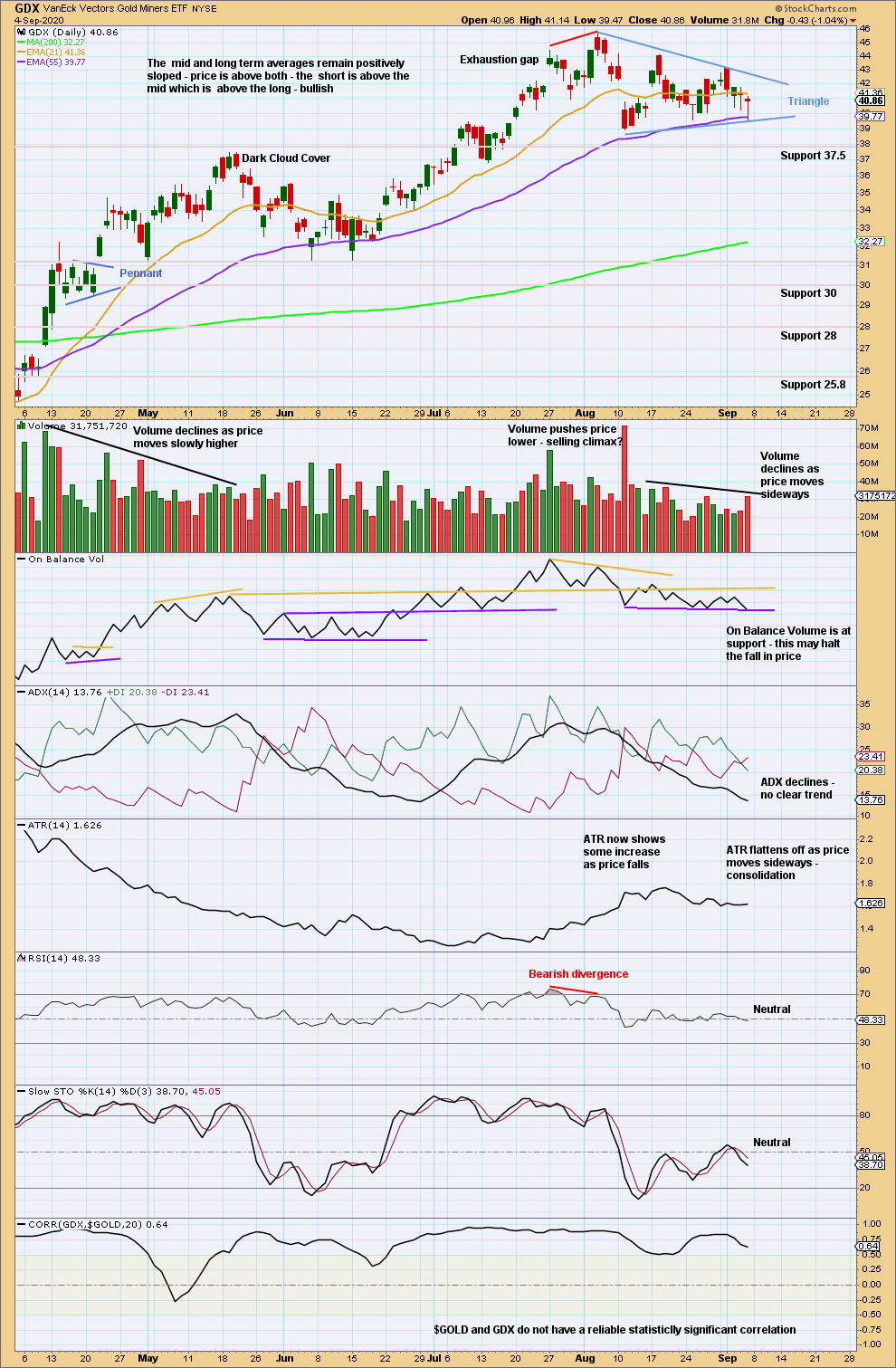
Click chart to enlarge. Chart courtesy of StockCharts.com.
A triangle may be forming. A breakout either upwards or downwards is required before a target can be calculated. An upwards breakout requires support from volume for confidence.
US OIL
A pullback was expected and has finally begun to show some strength.
Summary: Oil may have found a major sustainable low.
A multi-week pullback is expected to end about 23.05. It is possible the pullback may be deeper than this though; the first major correction within a new trend for Oil tends to be very deep.
When this pullback may be complete, then an upwards trend should resume with increased strength.
ELLIOTT WAVE COUNT
MONTHLY CHART
The basic Elliott wave structure is five steps forward and three steps back. This Elliott wave count expects that US Oil has completed a three steps back pattern, which began in July 2008. The Elliott wave count expects that the bear market for US Oil may now be over.
A channel is drawn about Super Cycle wave (II): draw the first trend line from the start of cycle wave w to the end of cycle wave x, then place a parallel copy on the end of cycle wave w. Price has bounced up off the channel. This trend line is breached, which is a typical look for the end of a movement for a commodity.
The upper edge of the channel may provide resistance.
Following five waves up and three steps back should be another five steps up; this is labelled Super Cycle wave (III), which may only have just begun. Super Cycle wave (III) may last a generation and must make a new high above the end of Super Cycle wave (I) at 146.73.
Super Cycle wave (III) may only subdivide as a five wave impulse. New trends for Oil usually start out very slowly with short first waves and deep time consuming second wave corrections. Basing action over a few years may now have begun.
WEEKLY CHART
Super Cycle wave (III) must subdivide as an impulse. Cycle wave I within the impulse may be complete. Cycle wave II may not move beyond the start of cycle wave I below 10.24.
FIRST DAILY CHART
It is possible that cycle wave I may be over.
Cycle wave II may subdivide as any corrective Elliott wave structure except a triangle. The 0.618 Fibonacci ratio of cycle wave I at 23.05 is a preferred target, but it is possible that cycle wave II may be deeper than this.
Cycle wave II may not move beyond the start of cycle wave I below 10.24.
A new trend at cycle degree should begin with a five wave structure. This is labelled intermediate wave (1). When intermediate wave (1) may be complete, then intermediate wave (2) may not move beyond its start above 43.77.
ALTERNATE DAILY CHART
This labelling sees primary wave 3 longer than primary wave 1, with a close Fibonacci ratio of equality. Primary wave 4 may be continuing lower as an expanded flat.
The best fit channel is adjusted to contain the slowing end of cycle wave I. If this channel is breached by downwards movement next week, then this wave count may be discarded.
Primary wave 4 may not move into primary wave 1 price territory below 27.97.
Cycle wave II may not move beyond the start of cycle wave I below 10.24.
TECHNICAL ANALYSIS
WEEKLY CHART
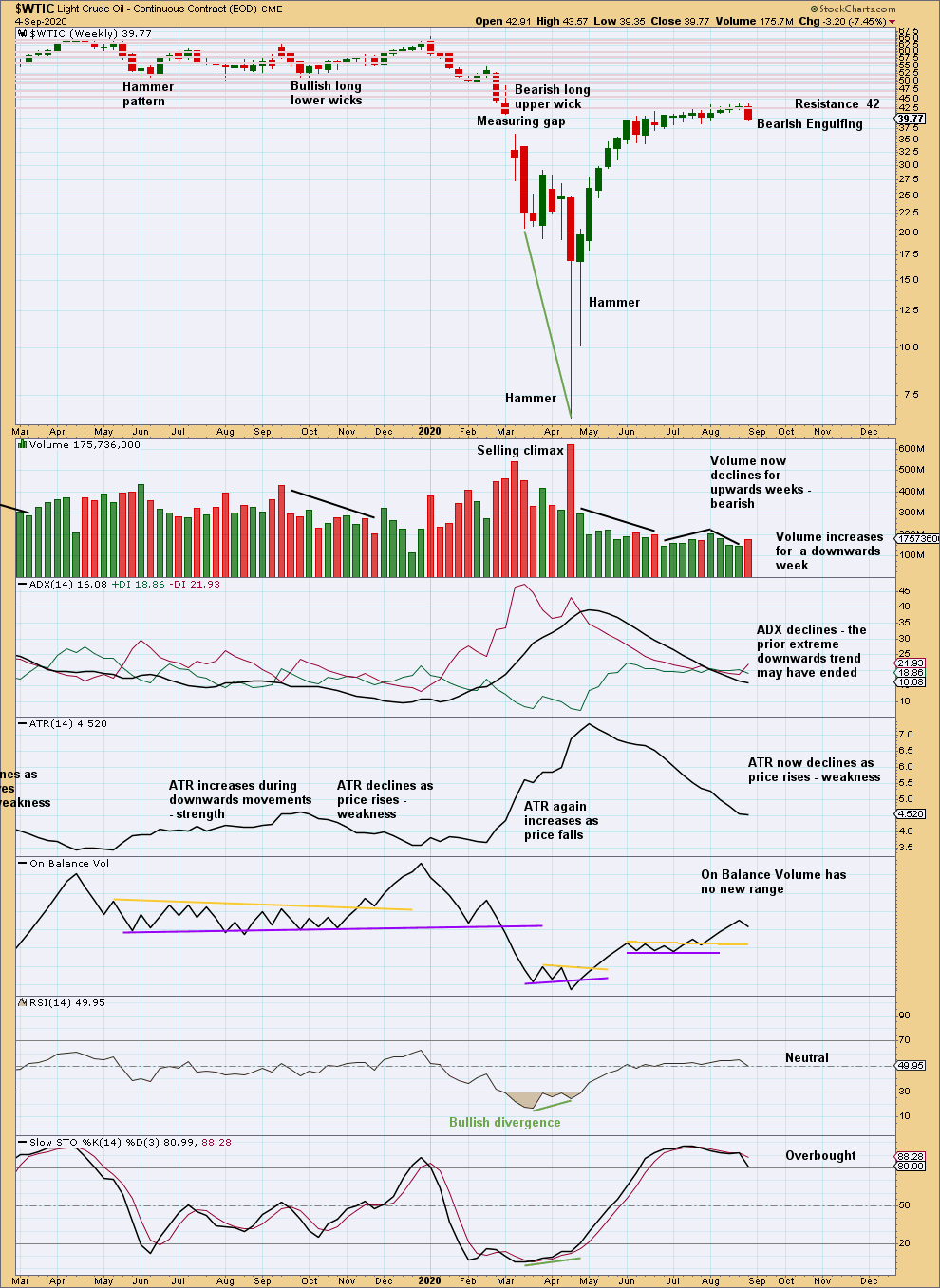
Click chart to enlarge. Chart courtesy of StockCharts.com.
A Bearish Engulfing pattern this week has support from volume pushing price lower. It looks like a rounded top is forming, and price may move lower from here to bring extreme conditions closer to the mean.
DAILY CHART
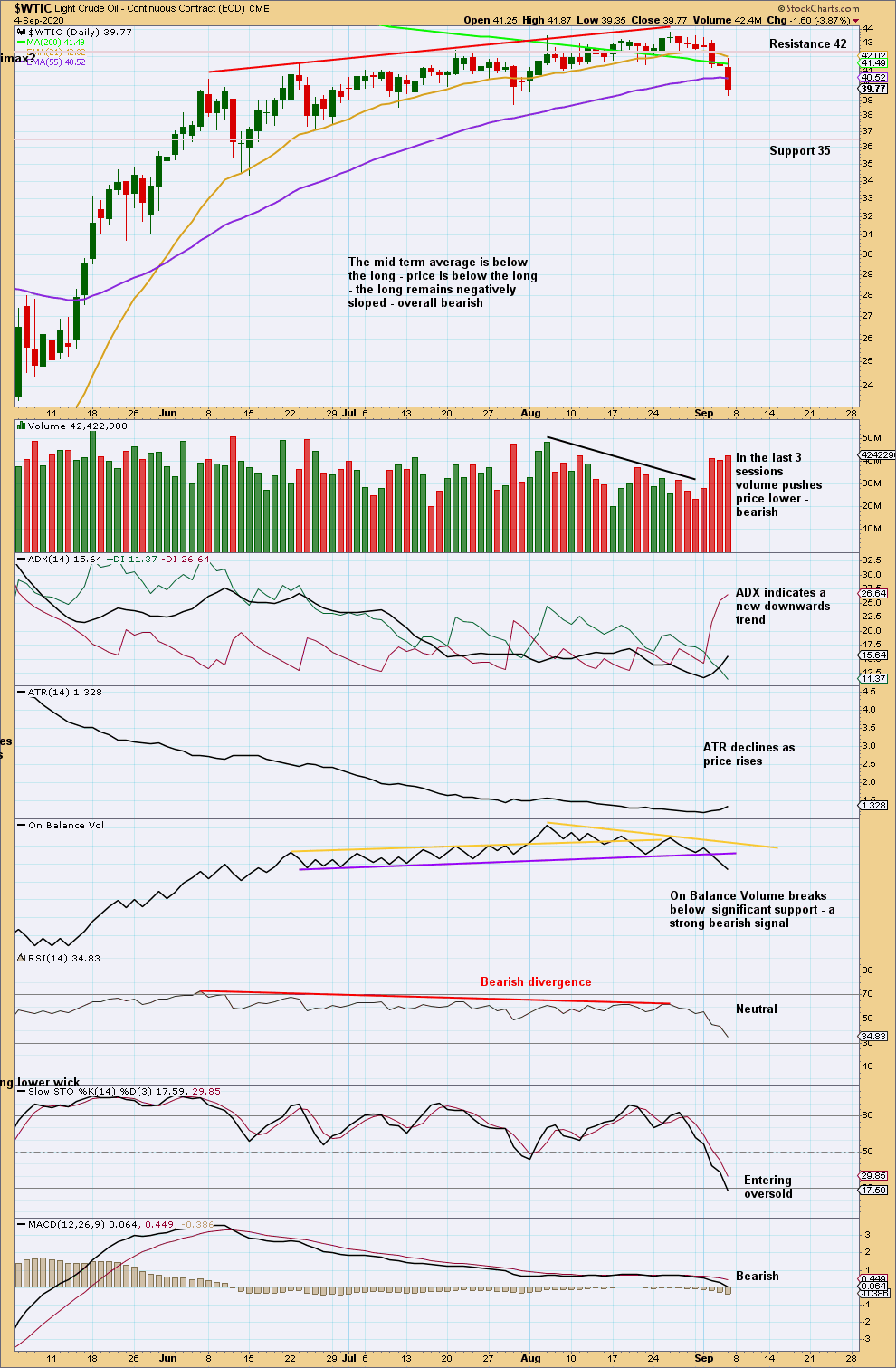
Click chart to enlarge. Chart courtesy of StockCharts.com.
There is a new downwards trend in an early stage. Expect it to continue until conditions reach oversold or a bullish candlestick pattern forms.
—
Always practice good risk management as the most important aspect of trading. Always trade with stops and invest only 1-5% of equity on any one trade. Failure to manage risk is the most common mistake new traders make.

